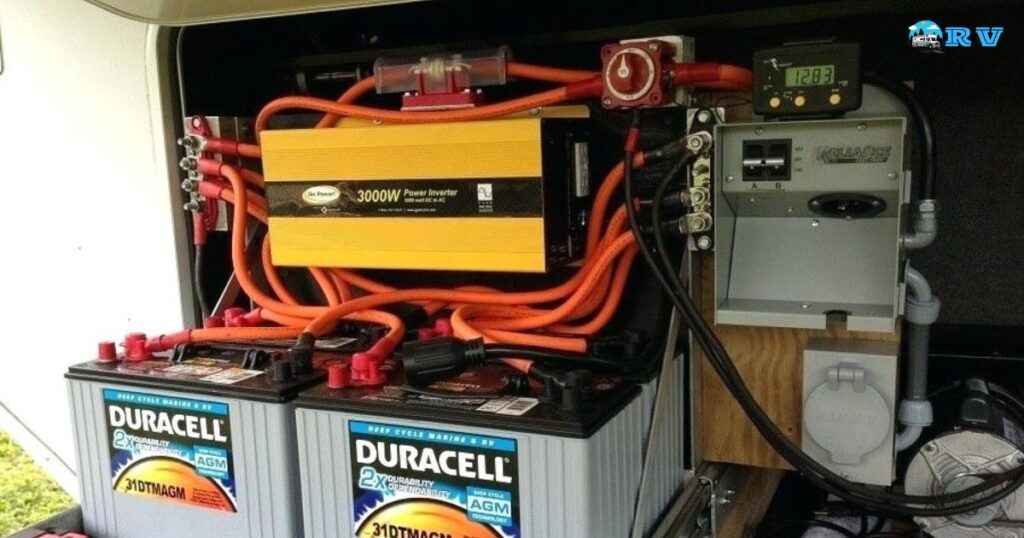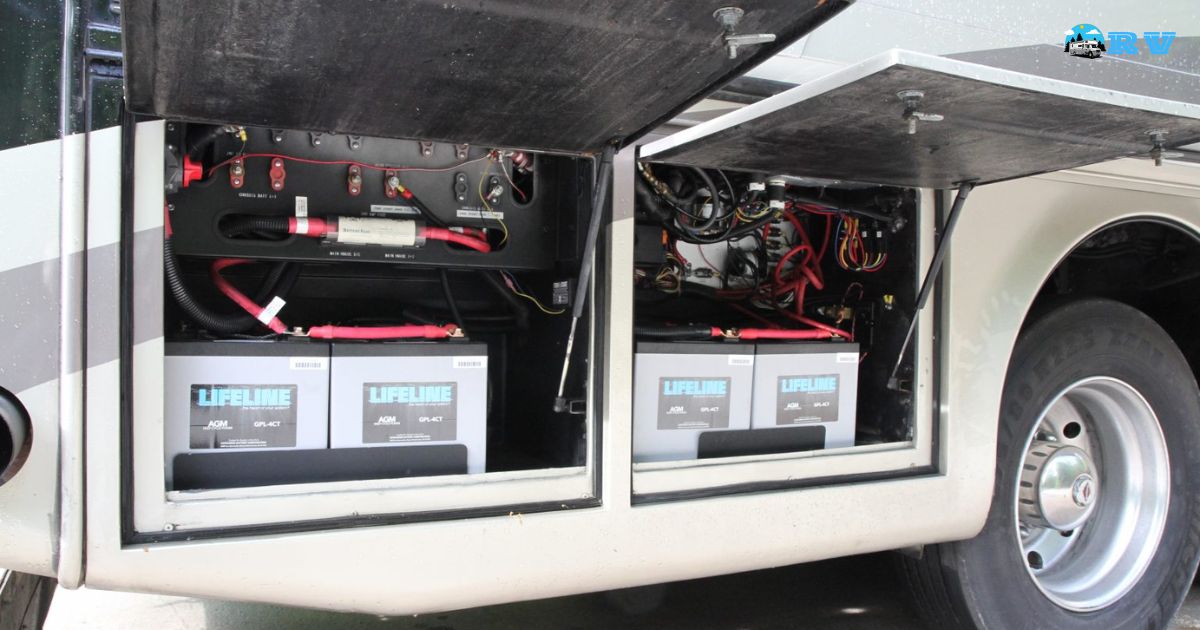In the context of RVs, two batteries typically refers to having a dual battery setup. This setup involves connecting two batteries in a specific manner to enhance the electrical capacity of the recreational vehicle. It’s a common practice among RV enthusiasts to extend the power availability for their vehicles.
Are you ready to take your RV experience to the next level? Understanding how to hook up two batteries in an RV can be a game changer. This knowledge not only improves your RV’s power capacity but also ensures you’re prepared for longer journeys or remote camping adventures.
Hooking up two batteries in an RV involves either a series or parallel connection. The choice depends on whether you need increased voltage or amperage. It’s a strategic enhancement that extends the time your RV can run off-grid, powering appliances and lights without the need for external power sources.
RV Basics Understanding the Need for Two Batteries
Hooking up two batteries in an RV is a smart way to extend your vehicle’s power capacity. This setup is essential for longer trips or when camping in remote areas without access to external power sources. Having two batteries allows for a more reliable power supply, ensuring your RV’s electrical systems function smoothly.
It’s particularly useful for running high-energy appliances like air conditioners and refrigerators. Understanding this need is the first step in enhancing your RV’s autonomy and comfort. The decision to add a second battery to your RV setup should be based on your power usage and travel habits.
If you frequently camp off-grid or use power-intensive appliances, a dual battery system is almost a necessity. It provides peace of mind, knowing you have enough power for your needs. Plus, it reduces the strain on a single battery, potentially prolonging its life. Consider your power needs to determine if a dual battery system is right for you.
Choosing the Right Batteries for Your RV Setup
Selecting the right batteries for your RV is crucial for an effective dual battery setup. There are various types, including lead-acid, AGM, and lithium batteries, each with its own advantages and limitations. Lead-acid batteries are cost-effective and widely available but require regular maintenance. AGM batteries, on the other hand, are more expensive but offer better performance and are maintenance-free.
Lithium batteries are becoming increasingly popular in RV setups due to their longevity and efficiency. They are lightweight, have a high energy density, and require no maintenance. They are the most expensive option. Your choice should be based on your budget, the specific power requirements of your RV, and how often you use your vehicle.
RV Power Management Series vs Parallel Connections
| Connection Type | Voltage | Amperage | Suitable For |
| Series | Increased | Same as one battery | 12V appliances |
| Parallel | Same as one battery | Increased | High-amperage demands |
When hooking up two batteries in an RV, you can connect them in series or parallel. A series connection increases the voltage while keeping the amperage same as a single battery. This is suitable for systems that require a higher voltage, such as certain 12V appliances. On the other hand, a parallel connection maintains the voltage but increases the amperage, ideal for high-amperage demands.
Understanding the difference between these connections is key to optimizing your RV’s power system. A series connection is typically used when the appliances or systems in your RV require a higher voltage. Parallel connections are preferred when you need more capacity or amperage, like for extended off-grid camping.
Guide to Hooking Up Two Batteries in an RV

Hooking up two batteries in your RV starts with choosing the right location for them. They should be easily accessible but secure and protected from the elements. Ensure the area is ventilated, as batteries can emit gases during charging and discharging. Once you have selected the spot, securely mount the batteries to prevent movement during travel.
Next, connect the batteries following the series or parallel configuration based on your needs. Use high-quality cables and connectors to ensure a secure and efficient connection. In a series setup, connect the positive terminal of one battery to the negative terminal of the other. For a parallel setup, connect the positive terminals together and the negative terminals together.
RV Battery Safety Best Practices for Dual Battery Setup
Safety is paramount when dealing with RV batteries. Always wear protective gear, like gloves and goggles, when handling batteries to protect against acid spills and electrical shocks. Ensure the batteries are disconnected from the RV’s power system before starting any installation or maintenance work. This prevents accidental short circuits or electrical hazards.
Regularly inspect your batteries for signs of wear, corrosion, or damage. Keep the terminals clean and check the connections for tightness. For lead-acid batteries, check the electrolyte levels and top up with distilled water if needed. Avoid overcharging the batteries, as this can reduce their lifespan and effectiveness.
Maximizing RV Battery Life Tips for Dual Battery Maintenance
To maximize the life of your RV batteries, regular maintenance is essential. Keep the batteries clean and dry, and ensure the connections are free from corrosion. If you have lead-acid batteries, check the water levels regularly and refill with distilled water as needed. Avoid letting the batteries discharge completely, as this can shorten their lifespan.
Another key aspect of battery maintenance is proper charging. Use a quality charger that matches your battery type. Overcharging can damage the batteries, while undercharging can lead to sulfation, which reduces their capacity. If your RV is not in use for extended periods, disconnect the batteries and store them in a cool, dry place.
Troubleshooting Common Issues in RV Dual Battery Systems
Even with proper setup and maintenance, issues can arise in dual battery systems, such as RV air conditioner freezing up. Common problems include batteries not holding a charge, reduced power output, or one battery draining faster than the other. These issues often stem from improper connections, incompatible battery types, or a failing battery.
To troubleshoot, first check the connections to ensure they are tight and corrosion-free. Test each battery individually to check its health. If one battery is significantly weaker, it may need replacing. Ensure both batteries are of the same type and age for optimal performance. Regular troubleshooting helps identify and resolve issues before they become major problems.
RV Adventures How Dual Batteries Enhance Your Travel Experience
A dual battery system in your RV significantly enhances your travel experience. It allows for longer off-grid stays, giving you the freedom to explore more remote and serene locations. With more power at your disposal, you can use your appliances and gadgets without worrying about running out of power.
This is especially beneficial for RVers who enjoy boondocking or who travel to areas without hookups. The added reliability of a dual battery system also brings peace of mind. Knowing that you have a backup power source reduces the stress of potential power issues. It allows for more spontaneous and adventurous trips, as you’re less dependent on finding campsites with electrical hookups.
Essential Tools and Accessories for Your RV Battery Setup
Proper tools and accessories are essential for a successful RV battery setup. A high-quality battery charger, specifically designed for your battery type, is crucial. It ensures efficient and safe charging. Battery monitors are also useful for keeping track of charge levels and battery health. This helps prevent over-discharge and prolongs battery life.
Other important accessories include durable connecting cables, fuse blocks, and terminal protectors. A voltage regulator helps maintain a consistent charge and protects against voltage spikes. Investing in these tools and accessories not only makes the installation process smoother but also enhances the overall performance and longevity of your battery system.
RV Electrical Systems Integrating Two Batteries Effectively
Integrating two batteries into your RV’s electrical system requires a thoughtful approach. Ensure the batteries are compatible with your RV’s existing electrical system, including the charger and inverter. The integration should be seamless, allowing for easy switching between batteries and the main power source. This ensures a consistent and reliable power supply.
Proper integration also involves balancing the load between the batteries. This ensures equal usage and charging, prolonging their life. It’s important to regularly check the system to ensure it’s functioning optimally. Effective integration not only enhances power efficiency but also adds to the overall functionality and convenience of your RV.
The Impact of Dual Batteries on RV Solar Power Systems
For RVers with solar power systems, adding a second battery can significantly enhance performance. A dual battery setup provides more storage capacity for solar energy, allowing for longer use of stored power. This is particularly beneficial for those who rely heavily on solar power for their energy needs.
Integrating dual batteries with solar panels requires a careful balance. The solar charge controller should be compatible with the battery setup to ensure efficient charging. This setup maximizes the use of renewable energy, reduces reliance on external power sources, and promotes sustainable RV living. A well-balanced solar and battery system is a key component of an eco-friendly and self-sufficient RV lifestyle.
RV Battery Upgrade Transitioning to a Dual Battery System
Transitioning to a dual battery system in your RV is a straightforward process, but it requires careful planning. Start by assessing your power needs and choosing the right type of batteries for your setup. Ensure your RV’s electrical system can accommodate the additional battery and make any necessary adjustments.
The installation process involves selecting a suitable location for the second battery and securely mounting it. Then, connect the batteries using either a series or parallel configuration, based on your power requirements. After installation, test the system to ensure it’s functioning correctly.
FAQs
How do I connect two batteries in an RV?
To connect two batteries in an RV, use parallel wiring, connecting the positive terminal of one battery to the positive terminal of the other, and the same for the negative terminals.
What are the advantages of hooking up two batteries in my RV?
Hooking up two batteries in your RV provides increased electrical capacity, longer-lasting power, and better performance for your appliances and devices.
Can I mix battery types in my RV setup?
It’s not recommended to mix battery types (e.g., lead-acid and lithium) in an RV setup, as it can lead to compatibility issues and reduced performance.
Conclusion
Upgrading to a dual battery system in your RV is a game-changer for any avid traveler. It ensures a more reliable and extended power supply, vital for those long journeys and remote adventures. With this setup, you gain the freedom to explore further and enjoy the comforts of home, even when off-grid.
The process, from choosing the right batteries to maintaining them, is straightforward and immensely rewarding. It’s an investment in both convenience and peace of mind. Making this switch not only enhances your travel experience but also brings practical benefits.
Longer battery life, increased power capacity, and improved self-sufficiency are just a few of the advantages. Whether you’re a seasoned RVer or just starting out, embracing a dual battery system opens up a new world of possibilities. It’s a step towards more adventurous, worry free, and enjoyable travels in your home on wheels.











